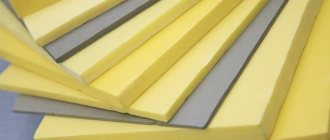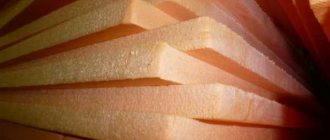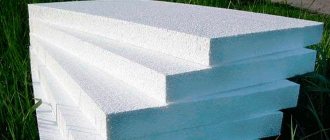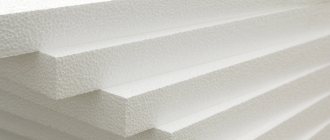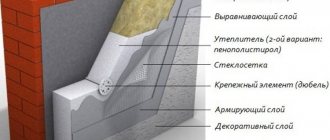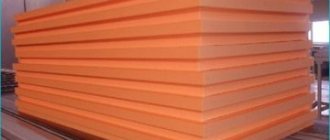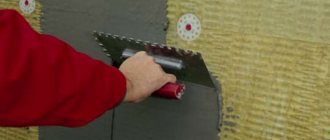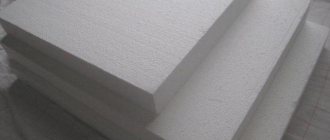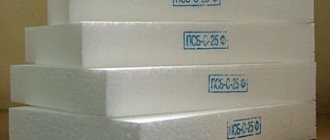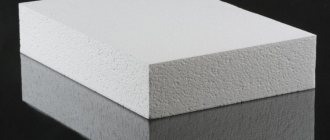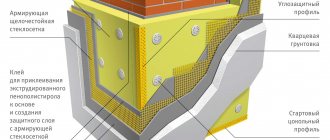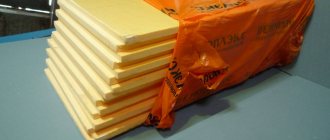Below is a list of frequently asked questions and answers related to PENOPLEX ® thermal insulation:
Using PENOPLEX indoors?
The molecules of polystyrene used in the production of PENOPLEX ® thermal insulation consist only of hydrogen and carbon atoms, so the material is completely environmentally friendly and safe for humans. Polystyrene, from which PENOPLEX ® thermal insulation is made, is also used for the manufacture of children's toys, disposable tableware, food packaging, medical products, etc. Items made of polystyrene surround us every day in everyday life: refrigerator parts, cocktail straws, egg packaging, yogurt jars and much, much more.
PENOPLEX ® is an environmentally friendly insulation material and does not contain small fibers, dust, phenol-formaldehyde resins, soot and slag. This material can be used as thermal insulation for internal and external insulation of building envelopes of residential, public, agricultural and industrial buildings and structures, as well as for external insulation during the construction of household water supply and sewerage facilities.
According to the results of the sanitary and epidemiological examination, the products of POLYSTYRENE FOAM EXTRUSION PENOPLEX, manufactured according to TU 5767-006-56925804-2007 and TU 5767-006-54349294-2014, meet the established requirements.
Do mice chew PENOPLEX ® and how to protect your home from rodents?
Conclusions based on the results obtained from a study of the attractiveness of extruded polystyrene foam for rodents:
Taking into account the results of biological tests, PENOPLEX ® can be exposed to rodents, but to a much lesser extent than other thermal insulation materials - only in cases where the thermal insulation is a barrier to food and water.
As for protection against rodents, in private housing construction the most widely used method is to protect thermal insulation, which is in the public domain for rodents, using a metal mesh with a mesh size of about 5 mm.
Sound insulation (sound insulation) PENOPLEX ®
Sound insulation of the partition (gypsum board 12.5 mm thick + PENOPLEX ® 50 mm thick) is 41 dB. Such a partition can be used as an interior partition in residential buildings of categories B and C (according to SNiP 23-03-2003).
The index for improving noise insulation in a floating floor structure when using a slab with a thickness of 20-30 mm will be 23 dB, which in most real cases ensures compliance with regulatory requirements for sound insulation.
Differences between PENOPLEX ® and non-pressed polystyrene foam (PSB)
PENOPLEX ® boards and expanded polystyrene (PSB) differ in their production technology. Pressless polystyrene foam is created by “steaming” microgranules with water vapor in a special form and expanding them under the influence of temperature. Thermal insulation PENOPLEX ® is made by mixing polystyrene granules at elevated temperature and pressure with the introduction of a foaming agent and subsequent extrusion from the extruder. That is why PENOPLEX ® expanded polystyrene is called extruded. Also, thanks to the production technology using this technology, PENOPLEX ® receives a closed, fine-porous structure, which in turn ensures high strength, almost zero water absorption, as a result - biostability and the highest durability of PENOPLEX ® boards. An important factor is also the lower thermal conductivity of PENOPLEX ® compared to pressless polystyrene foam (PSB), which makes it possible to reduce the thickness of the required thermal insulation by approximately 30%.
Which insulation to choose: PENOPLEX ® or mineral (stone) wool?
What is better PENOPLEX ® or mineral wool? This is a question that arises quite often among private developers. Each of these materials has its advantages. For example, PENOPLEX ® is practically indispensable in loaded structures and humid environments, while mineral wool performs better in sound insulation. In addition, some types of mineral wool have a lower price, but this advantage often disappears due to the low quality of such wool, which results in high shrinkage, as well as the need for greater thickness of thermal insulation.
PENOPLEX ® is distinguished from mineral wool by a number of characteristics:
- lower thermal conductivity coefficient.
- high compressive strength
- absolute moisture resistance (PENOPLEX ® does not absorb water, due to which it retains its thermal insulation properties throughout its entire service life).
- absolute biostability (PENOPLEX ® is not a matrix for the development of bacteria, mold and other microorganisms).
- ease of installation (PENOPLEX ® does not require special protective equipment when working with it).
What is the density of PENOPLEX ®?
The density of PENOPLEX ® boards for private use ranges from 23 to 35 kg/m3. For the professional segment, this figure can reach up to 45 kg/m3. It is important to understand that the density of PENOPLEX ® is not a key factor in determining the scope of application of the material. A more important characteristic is compressive strength. The strength characteristics of PENOPLEX ® vary over a wider range. The minimum compressive strength at 10% deformation for PENOPLEX ® slabs is 0.12 MPa; such slabs are used for non-load-bearing structures (for example, for wall insulation). The slabs intended for insulating foundations have higher compressive strength values - 0.3 MPa, since it is these structures that bear the main loads from the building. PENOLEX ® grades intended for road construction and structures with increased loads can have a strength of 0.50 MPa and higher.
A wide range of characteristics allows the use of PENOPLEX ® slabs for insulation of almost any structures, both in cottage and low-rise buildings, as well as in industrial and civil construction.
What is the melting point of PENOPLEX?
The temperature range for use of PENOPLEX ® boards is in the range from -70 to +75 degrees Celsius, which allows the use of this material in any climatic zones.
At temperatures above 75 degrees Celsius, PENOPLEX ® can change its mechanical properties in the direction of reducing the strength of the material.
How many bricks does PENOPLEX ® replace?
If we compare materials in terms of thermal insulation properties, a PENOPLEX ® slab with a thickness of 50 mm (λ = 0.034 W/m2°C) will replace 1280 mm of masonry on a thermal insulating mortar made of solid single brick (λ = 0.82 W/m2°C). (According to GOST 530-2012 Ceramic brick and stone. General technical conditions. Table D.1 - Thermal characteristics of solid (conditional) masonry).
On average, in terms of thermal insulation properties, 1 cm of PENOPLEX ® replaces 25 cm of brickwork, but it should be remembered that for each individual type of brick (silicate, ceramic, clinker) this comparison will be different.
Penoplex is one of the most popular insulating materials. Its main advantage is ease of use. Any person, even those who do not have construction skills, can insulate the floor with penoplex with their own hands. This universal material is suitable for insulating apartments, loggias, balconies and private houses. It can be laid on concrete, wood and soil foundations.
Description of penoplex
The material is based on foamed polystyrene. Unlike polystyrene foam, it has a dense and elastic structure. Penoplex holds air well and does not allow water to pass through, so it is used to insulate both heated and unheated rooms. Many experts note excellent protection from the cold when insulating floors with penoplex.
Penoplex is often used when installing “warm floors”
There are different types of material that differ in density, thickness and fire resistance. The usual width of the slabs is 600 mm, length - 1200 or 2400 mm. They have a thickness from 20 to 100 mm. The insulation is sold in packs of 4-20 sheets.
Penoplex has the following advantages:
- low moisture absorption;
- high degree of vapor and heat insulation;
- strength and reliability;
- resistance to microorganisms;
- environmental friendliness.
This video will tell you how to insulate the foundation of a building with penoplex with your own hands:
Well-laid penoplex protects from low temperatures, noise, moisture, and creates comfortable living conditions. Its disadvantages include low resistance to solvents and high temperatures.
Thick and dense penoplex is used in places where good thermal insulation is required. It is often used in construction. It insulates floors with a concrete or soil base well. Often the material is laid in 2 layers.
Depending on the part of the house to be insulated, the thickness of the penoplex is selected
Using such an expensive material as penoplex to insulate attics is impractical. Cheaper insulation materials with lower thermal conductivity are suitable for this purpose. It is economically profitable to use penoplex when:
- insulation of floors of apartments on the first floors;
- insulation of loggias;
- installing floors in bathhouses;
- insulation of low-rise buildings;
- installation of heated floors.
Eps insulation
This is a unique material that has the following properties:
- low water absorption, almost equal to zero;
- high strength;
- not subject to rotting;
- low thermal conductivity;
- high frost resistance;
- non-toxic to humans;
- easy to install;
- durability;
- light weight;
- environmental friendliness.
The disadvantages of polystyrene foam insulation include:
- strong flammability and intolerance to direct sunlight. This is important to know, because storing polystyrene foam in the sun can completely ruin the material, and this will be unpleasant;
- Although manufacturers claim that polystyrene foam is not chewed by mice, consumer reviews show the opposite;
- And of course the price, which is quite high.
But what is the difference between Technoplex and Penoplex? What's better?
Self-installation
The insulation is mounted on foundations made of reinforced concrete, soil and wood. When working, the following rules should be observed:
- strictly follow the installation instructions;
- Carefully adjust the slabs to each other so that there is no free space between them.
- Distortions and rolls are unacceptable.
If the material is laid in two layers, then you need to ensure that the joints of the upper plates do not coincide with the joints of the lower ones. Otherwise, pockets filled with air will appear in the insulating layer. Condensation will accumulate in them. Such defects impair thermal insulation and subsequently lead to delamination of the insulation.
A special compound is used to glue the boards together. It improves the thermal insulation properties of insulation. A “finish floor” is laid on top of the penoplex, for which the following materials are used:
- laminate;
- linoleum;
- parquet;
- polymer coating;
- ceramic tiles;
- boards.
Decorative coating is mounted on foam boards
Penoplex K
Roofing Penoplex K
This type of insulation replaced Penoplex type 35 with fire retardants. Thanks to modern manufacturing technology (extruding polystyrene foam using carbon dioxide until a fine-cell structure is achieved), this type of insulation has not only the minimum thermal conductivity in the segment of materials of this class, but also excellent sound insulation properties.
Compared to its predecessor, this material has much greater fire resistance and excellent resistance to static loads, including compression, due to which it is in demand in civil, industrial and road construction, insulation of utility lines (an alternative to the outdated type 31C).
| Parameter | Type K * | Comfort | The basis | Pitched roof |
| Slab density, kg/m³ | 28,0-33,0 | 25,0-30,0 | 25,0-32,0 | 28,0-33,0 |
| Compressive strength (at linear deformation 10%), MPa, not less | 0,25 | 0,18 | 0,20 | 0,25 |
| Tensile strength (for static bending), MPa, less | 0,4 | 0,4 | 0,25 | 0,4 |
| Water absorption over 24 hours/28 days, % by volume, no more | 0,4/0,5 | 0,4/0,5 | 0,4 | 0,4/0,5 |
| Fire resistance category | G3 | G4 | G4 | G4 |
| Thermal conductivity at 25±5°С W/(m×°K) | 0,03 | 0,31 | 0,03 | 0,03 |
| Calculated thermal conductivity coefficients (operating conditions A/B), 25±5) W/(m×°K) | 0,03 | 0,032 | 0,031/0,032 | 0,031/0,032 |
| Sound insulation, Rw | 41 | 41 | 41 | 41 |
| Improvement index for structural noise insulation in floor construction, dB | 23 | 23 | 23 | 23 |
| Operating temperature range, °C | -50 to +75 | -100 to +75 | -100 to +75 | -100 to +75 |
* The product has been discontinued.
Ground mounting
Penoplex is widely used to insulate earthen floors. Floors on the ground are installed as follows:
- Carefully level the installation site.
- Cover it with expanded clay and sand to a height of 40 cm. The layers should be positioned strictly horizontally.
- Insulation boards with a thickness of 5 cm or more are laid. The sheets are carefully joined together, leaving no gaps. The joints are sealed with tape.
Penoplex can be used to effectively insulate an earthen floor
- The entire base along the edges is covered with roofing felt or polyethylene. They are also mounted on penoplex.
- Cement is poured on top, on which a metal mesh is laid to strengthen it. Its layer must have a thickness of at least 5 cm.
- The screed must be strictly leveled horizontally, otherwise difficulties will arise when laying the floors.
Installing a floor in a bathhouse has its own characteristics. Here the screed is installed at an angle to ensure water drainage. To cover the floor, it is better to use sanded boards mounted on joists.
Comparison
The main technical characteristics of insulation are its thermal conductivity, water absorption and operating temperature.
The flammability group for both insulation materials is G4 (highly flammable).
Their prices differ by 10% (Technoplex is more expensive).
After comparing them, it is clear that there are no significant differences between these insulation materials.
Yes, Technoplex has slightly better characteristics, but the cost is also higher. Despite the fact that Penoplex is cheaper, with individual construction the savings are insignificant.
Installation on a finished base
To properly insulate the floor with penoplex, you first need to remove the old floor covering: linoleum, tiles, laminate, boards. Otherwise, the new coating will inherit all the defects of the old one. After this, carefully inspect the concrete base. Correct all imperfections: cracks, chips, unevenness. To level the surface, you can use a small layer of filler floor.
Before laying foam boards, it is advisable to dismantle the old floor covering
Insulation is laid on a flat base. Its installation is carried out using a special glue that does not corrode penoplex. Waterproofing is laid on top of the insulation, and then a concrete screed is made.
The floor insulation on a balcony or loggia is carried out in the same way. The old floor covering is removed, the concrete base is leveled, insulation, waterproofing and a layer of concrete screed are laid. If a balcony or loggia is located above the first floor, then for insulation it is enough to use foam sheets 3 cm thick. The concrete screed can have the same thickness.
For a small balcony or loggia, instead of a cement screed, you can use any waterproof material of sufficient rigidity. For loggia walls, thin foam sheets can also be used as insulation.
Extruded polystyrene foam
Penoplex is a tile insulation made from extruded polystyrene foam. Unique thermal insulation characteristics are achieved thanks to the smallest cells filled with air.
Penoplex has a bright and recognizable orange color. Penoplex has excellent chemical resistance, but it is important to know that it is absolutely not resistant to gasoline (just like Technoplex). Due to its good strength properties, Penoplex can be used for external insulation.
There are different types in the Penoplex line (their names speak for themselves):
- roofing (insulation of attics and roofs of various configurations);
- wall (basement, walls, partitions, facade are insulated);
- foundation (used as insulation for the basement and floor of the first floor);
- comfort (can be used for any work, but is especially well suited for insulating apartments and balconies);
- 45 (has the best characteristics of all types, used in road construction and bridge construction).
. Penoplex is available in standard width and length - 600 mm by 1200 mm, respectively. But the thickness varies - from 20 mm to 150 mm.
Penoplex is used at temperatures from -50 0 C to +75 0 C. Water absorption - 0.4% - slightly worse than Technoplex, but still a very high figure. Thermal conductivity is 0.03 W/(m*K).
This material will help you find out which polystyrene foam or polyurethane foam is better:
Use for wood floor
Penoplex here is laid directly on a wooden base: fiberboard, plywood or boards. First, remove the baseboards and remove the finishing coating. Some of the boards are lifted and the joists are checked, and those that are rotten or eaten by bugs are replaced.
It is important that the floor surface is flat and strictly horizontal.
Protruding areas of the floor are removed by sanding, and the cracks are covered with putty. The sheets are adjusted to each other so that there are no gaps.
The floor surface is primed. Boards made of highly absorbent material are coated with primer several times. When the surface is dry, install the insulation. The joints between the sheets are sealed as much as possible. The gaps are filled with mounting foam that does not contain toluene, which corrodes the insulation. The insulating layer is covered with a vapor barrier, then plywood or chipboard slabs are attached. The flooring is laid on top.
Penoplex is a popular floor insulation material. It has a high level of insulation and is good protection against moisture and steam. It can be used for self-insulation of balconies and rooms with different floor subfloors.
Almost all apartments have very comfortable rooms - balconies or loggias, which previously were traditionally used only for drying clothes and storing necessary things that are not required very often. Now the attitude towards this living space has changed: at the “whim” of home owners, it is almost everywhere turning into a full-fledged residential area. However, in order for the functionality of the future mini-room not to depend on weather conditions, it is necessary to minimize the inevitable heat loss. To achieve the goal, owners use various materials. Not the least popular method is to insulate the floor with penoplex yourself. This option is attractive because the work does not require the highest qualifications from the master. Anyone can handle it.
What is the difference (main characteristics)
Penoplex is extruded polystyrene foam, the “grandson” of foam plastic, which has surpassed its “grandfather” in almost all consumer qualities, except price.
Mineral wool (basalt) is a fibrous material obtained from silicate molten rocks. In comparison with the usual glass wool known since Soviet times, basalt is already a product of evolution.
The raw materials and production technology of both materials are completely different.
Which is warmer ? To be fair, we will choose one option, for example, insulation for the facade. If we use 50 mm thick penoplex, then the equivalent would be a 60 mm thick basalt slab. In general, there is little difference.
Vapor permeability. Everything is immediately clear here. Penoplex - 0.013, basalt wool - 0.3. The difference is tens of times.
Conclusion: mineral wool is a “breathable” material, penoplex is virtually airtight. I can't say for sure whether this is good or not. It all depends on the application situation.
Water absorption. Everything is clear here too. Mineral wool absorbs liquid much more actively, after which it loses its thermal insulation qualities.
Penoplex (according to test results), lying in a bath of water for a whole month, increased its mass by only 0.2%.
Noise insulation . With equal dimensions, a basalt slab will provide much more silence than penoplex.
Weight . It would be possible not to consider this indicator. Everything is clear to everyone, penoplex is several times lighter than a similar-sized piece of basalt insulation.
Flammability . The clear leader is mineral wool. It practically does not burn (unless you place it in a melting furnace with a temperature of more than 1000 ° C). Although the binder adhesive base it contains is subject to combustion, this is a very small volume of the product.
Penoplex not only melts, but also burns when exposed to an open flame (and the antipyrines added to its composition are not designed for long-term fire protection). In addition, when it burns, toxic substances are released.
Conclusion: penoplex is not suitable for insulating rooms with a high fire hazard.
Environmentally friendly. It's hard to say here. The fact is that manufacturers of both materials have sanitary and hygienic documents allowing their use for housing. Previously, when there was no polystyrene foam, but foam plastic (in the production of which freon was used), there was a danger, but now (according to official data) new materials based on expanded polystyrene foam use safe technologies and materials. The same applies to basalt wool. Although for both materials it is assumed complete isolation from respiratory and tactile contact with them inside the house.
Ease of installation. According to reviews from builders (and I’ll say the same thing myself), if a flat surface is insulated, the penoplex is installed faster. It is lightweight, easy to cut and grind, and if there is a side L-shaped edge, then the problem with cold bridges is solved. And it does not require a layer of vapor barrier. But if there is no tongue-and-groove edge, the seams must be sealed or laid in two overlapping layers. And this is already additional labor costs.
Penoplex lock
In the photo - L-shaped edge of penoplex
Basalt wool is heavier, but it fits complex geometric structures and disproportionate areas more effectively. True, working with it requires special clothing, and ideally, also goggles with a respirator to protect the eyes and respiratory organs from fibrous particles. Although in most cases, installers neglect this. But in vain.
Life time . Indecently large. Both of them (according to the manufacturers) last at least 50 years. But this is provided that the materials are protected from external atmospheric, mechanical and chemical influences. Has anyone checked? They have been produced for a little over 20-30 years.
By the way, they are not afraid of biological destruction in the form of fungal mold, rot, bugs and rodents (again, according to the manufacturer). Although I remember before, mice didn’t particularly disdain polystyrene foam and mineral wool, in any case, they gnawed out their own passages. And a year ago, in a friend’s temporary hut, insulated with penoplex, mice were gnawing through rather voluminous tunnels. So, here you can argue with the manufacturer about rodents...
Basalt wool has one drawback that manifests itself over time. This is shrinkage. Its formation slightly reduces the thermal conductivity of the material.
Price . If you compare penoplex and high-quality “cotton” insulation (say, Rockwool, URSA or KNAUF brands), then the difference in price will be small. You will spend almost the same money.
It seems like I listed all the main pros and cons. I didn’t give any specific figures, since we are comparing in general terms and not specific brands. For example, basalt wool and penoplex have several models designed for insulating different surfaces (foundation, floors, walls, roofing).
What is penoplex?
Penoplex is an extruded polystyrene foam (EPS), produced by the Russian company of the same name, which became a pioneer in the mass production of insulation materials. Unlike its predecessor, polystyrene foam, EPS is made using a completely different technology, so the quality of the extruded “newbie” and its characteristics are very different for the better.
Extruded polystyrene foam is made by foaming raw materials. This processing allows you to obtain a lightweight but incredibly durable material, inside of which there are tiny air bubbles. Thanks to these numerous cells, penoplex has the highest thermal insulation properties.
It is easy to distinguish real “penoplex” from other brands of extruded polystyrene foam: it has a “Dutch” orange color. These are slabs 600 mm wide, their length is 1200 or 2400 mm (only 45 and 45C). The thickness of the material varies: a maximum of 100 mm, a minimum of 20. It is this that determines the number of sheets in the package - there are only 4 thick slabs, the thinnest ones can be 20.
What is extrusion
The heat-retaining properties of extruded polystyrene foam are an order of magnitude higher than those of related foam plastic that has not gone through an extruder
More than half a century ago, American engineers developed polystyrene extrusion technology, which is now successfully used in the production of building materials with high thermal insulation properties.
Polystyrene granules are mixed under high pressure and temperature with foaming agents (a mixture of non-toxic light freons).
The resulting material from this process has a cellular structure. The remaining freons in the cells are quickly replaced by air. Microscopic closed cells are located evenly throughout the entire volume of the slab.
Various additives (graphite, fire retardant additives) are added to polystyrene foam produced by extrusion, which enhance the beneficial properties of the material.
Pros and cons of EPS
Penoplex is more expensive than regular polystyrene foam, but its price is quite justified. EPS has a lot of undeniable advantages, however, the material also has disadvantages.
Advantages
Among the positive qualities of extruded polystyrene foam, several strengths can be noted. These include:
- Environmentally friendly. Since EPS does not emit harmful substances into the surrounding space, it can even be safely used to insulate the floors of children's rooms.
- Ease of use. Unlike polystyrene foam, penoplex can be cut very well with a sharp knife. There are also few crumbs left.
- High moisture resistance. It is determined by the structure of the material itself, which is why penoplex is used for internal and external insulation.
- Resistance to mechanical deformation. This is the main advantage of penoplex, thanks to which it is so popular for floor insulation.
- A high degree of sound and heat insulation, along with a small thickness and lightness, make the insulation almost ideal for apartments in multi-storey buildings.
- Long service life. Manufacturers of extruded polystyrene foam assure that this insulation, with error-free installation, will last 50 (or more) years.
- Some types of slabs are equipped with counter-directional protrusions, guaranteeing almost one hundred percent solidity of the heat-insulating layer without additional sealing.
These advantages of penoplex provide a chance for simple, relatively quick insulation of the balcony floor; despite the speed of work, it will be of high quality.
"Long Minus"
Good material has disadvantages: it is afraid of solvents and very high (low) temperatures, but this disadvantage can be ignored. But it should be noted that the price is quite decent, which cannot be considered an advantage either. But penoplex has one big disadvantage - the relative ease of ignition and the release of toxic substances during combustion. To protect polystyrene foam, fire retardant additives are added to it. But it’s easy to combat this “weakness” - just place the insulation between layers of some non-combustible material.
Since the shortcoming is significant, it requires some explanation. All building materials are divided into 5 groups, differing in the degree of flammability. The safest ones are “NG” - non-flammable. Its “bright” representative is mineral wool. The most unreliable group is “G4”. The materials included in it are capable of spreading flames. An example is ordinary white foam.
There are several brands of penoplex; they are intended for different areas of the apartment, so they must differ in flammability class. Manufacturers position some brands (with fire retardant additives) as belonging to “G1” - the group that contains low-flammability, self-extinguishing types; they are not characterized by the spread of fire.
In reality, everything is not so rosy, this is the opinion of the builders. They are more skeptical and classify almost all brands of penoplex into the “G3” and “G4” groups. It contains materials that are quite difficult to ignite, burn steadily, but tend to fade. Extremely toxic smoke is the main danger to humans: it should not be inhaled under any circumstances.
If you plan to insulate the floor with penoplex yourself, then the best type for any premises, and especially for small balconies, are brands with a minimum degree of flammability. Reliably fencing them with materials that are not afraid of fire is the most important condition, and it is also quite feasible. Therefore, recently extruded polystyrene foam has been successfully squeezing out its competitors - mineral wool and polystyrene foam, because the list of its disadvantages is very small, but its advantages are significant.
Flammability
Both products belong to the fourth fire resistance group.
Many novice builders believe that materials made from polystyrene foam have properties similar to polystyrene foam, but in reality everything looks somewhat different.
High-quality material does not support combustion.
If polystyrene foam easily ignites under the influence of an open fire, then penoplex and technoplex begin to melt under the influence of high temperatures, but they do not support combustion. During this process, carbon dioxide and carbon monoxide are released.
How to choose penoplex for a balcony?
There is a sufficient range of brands on the market, but it is this diversity that makes it somewhat difficult to find the best candidate for insulating the floor on the balcony. When choosing, you need to start from:
There are the following brands of EPS:
- 31, 31С. These products are characterized by low strength and low density - its maximum value is 30.5 kg/m³. Therefore, they are not suitable for insulating the floors of balconies.
- 35 - universal penoplex. It has sufficient density (up to 38 kg/m³) and compressive strength (83 kPa). It is used widely.
- 45, 45C. These brands are even stronger, their density ranges from 35 to 40 kg/m³. The materials are suitable for insulating foundations, so they are used to insulate balconies under screed.
Penoplex series - the second topic for familiarization:
- “C” - “wall” - for external walls;
- “K” - “roof” - for thermal insulation of attics and roofs;
- “F” - “foundation” - for bases, plinths;
- “Comfort” - for indoor work, these include balconies and loggias;
- "Geo" - for road and industrial construction.
If we talk about the optimal choice for a “semi-outdoor” room, then the leader will be the material marked with the letter “C”. The alternative is a series called “comfort”. Impregnation with fire retardants is a requirement already mentioned.
The optimal thickness of penoplex slabs for insulating a balcony is 20-50 mm. If the house is located in a region where winters are harsh, then choose thicker material. The thickness also depends on what effect the owners want to achieve.
- If the balcony is used as a room for drying clothes and is not heated, then the thermal insulation layer in this case can be 20-30 mm.
- When they plan to make a full-fledged room out of it, which will be visited regularly, they purchase penoplex with a thickness of at least 50 mm.
If all the characteristics have been considered, evaluated, and a suitable option has been found, then you can go shopping and then begin to prepare for the upcoming work.
Extruded polystyrene foam
Technoplex is a tile insulation made of extruded polystyrene foam with graphite particles. Thanks to graphite, the plates acquire a gray color and increased strength. 50 mm of technoplex is equivalent to a 600 mm wide foam block wall.
Insulation is produced in the form of slabs of various widths, lengths and thicknesses:
- Length – 1180/1200 mm.
- Width – 580/600 mm.
- Thickness – 20, 30, 40, 50, 100 mm.
Technoplex is operated at temperatures from -70 0 C to +75 0 C. Its water absorption is only 0.2% - this is a very good indicator. Thermal conductivity is 0.032 W/(m*K).
Materials, tools
In addition to penoplex, other materials will be needed to insulate the balcony. To work you will need:
- timber (50x50 mm), boards (20x100 mm) with a length similar to that of a balcony, slats (15x50 mm);
- waterproofing - coating or roll;
- antiseptic primer, putty;
- Chipboard, OSB or plywood (thickness - 15-20 mm);
- glue for penoplex;
- polyurethane foam and gun;
- Scotch tape - always foil;
- self-tapping screws, dowel-nails;
- foil polyethylene (penofol).
Heat insulator brand Comfort properties and characteristics
Penoplex "Comfort" is a modified and improved "Penoplex 31C" with universal characteristics. The material is actively used for insulating country houses, country houses and cottages. The high speed of installation and minimal labor costs popularize the insulation among private homeowners - it is used to insulate the subfloor, foundation and basement of a house, basement and roof, walls and partitions from the inside and outside of the building. Penoplex "Comfort" has high levels of moisture resistance and thermal conductivity. In the penoplex series line, the Comfort brand is recognized as universal.
Penoplex protects the soil from heaving when it freezes - when the soil is insulated with this material, the freezing point of the soil will rise. This series is optimal for insulating road and railway surfaces, runways and technical areas of airfields. Comfort slabs retain their unique characteristics throughout the entire period of operation. Characteristics of the “Comfort” penoplex insulation brand are in the table below:
It is a misconception to think that penoplex and foam plastic are brother materials. Some properties of penoplex can be equated to the parameters of polystyrene foam, but not flammability and water absorption.
Manufacturers have long mastered the production of both non-flammable polystyrene foam and high-burning polystyrene foam. But the truth is that penoplex cannot spontaneously ignite, and in an open fire zone it will only melt, releasing carbon monoxide (CO) and carbon dioxide (CO 2) gases. If the fire is extinguished, the penoplex will not even smolder.
When choosing the thickness of expanded polystyrene sheets that will be used to insulate a building, it is important to take into account the climatic characteristics of the region where it is located, the dimensions of the building and the material from which it is built. There are two operational and technological characteristics that directly affect the quality of insulation of polystyrene foam - thickness and density
There are two operational and technological characteristics that directly affect the quality of insulation of polystyrene foam - thickness and density.
In general, sheets with a thickness of 50 mm and a density of 25 kg/m3 are considered optimal. This is the type of material that is usually recommended to developers or repairmen who do not know what thickness of polystyrene foam to insulate a house. However, the specified thickness and density are not an inviolable standard and may vary depending on the specific conditions indicated above.
Preparatory stage
It is impossible to insulate a floor with penoplex yourself without prior preparation. The durability and efficiency of further work depends on the correctness of its implementation. Therefore, it is important to carefully consider all stages of the operation.
- Glazing. It is clear that without this operation, thermal insulation work will not bear fruit; it is simply meaningless.
- Cleaning surfaces of old coating - damaged or peeling. The cracked coating is completely dismantled, otherwise the accumulating moisture will not make the insulation effective.
- Checking the quality of the floor. If gaps or cracks are found, the surface is repaired. Defects between the floor and walls (parapet) are sealed with polyurethane foam. After the composition has dried, the excess is cut off.
- Waterproofing the lower part of the walls and concrete base. For these works, choose bitumen mastic, dense polyethylene, rubber paint or traditional roofing felt. The best option is roofing felt laid on mastic. Entering and fixing the material on the walls is mandatory.
- Treatment of walls with antiseptic primer. The number of layers is indicated on the product packaging, each of them must dry thoroughly before applying the next. If large colonies of mold are detected, serious treatment of all problem areas is necessary.
After the primer composition has completely dried, they begin to further transform the room.
Penoplex F
Penoplex for foundation
This is a high-quality insulation made from extruded environmentally friendly polystyrene foam, designed specifically for protection against freezing, which contributes to the destruction of concrete, and effective thermal insulation of the entire structure as a whole. In addition to temperature protection, external insulation with Penoplex F minimizes the harmful effects that groundwater or insufficient drainage quality have on the building foundation.
The main advantages of the updated version of insulation of this class include traditional ease of installation, reliability and durability, excellent thermal and waterproofing properties. Due to its unique characteristics, this type of Penoplex thermal insulation is in demand not only in civil, but also in road and engineering construction.
| Parameter | Type F * | Comfort | The basis | Foundation | Geo |
| Slab density, kg/m³ | 29,0-33,0 | 25,0-30,0 | 25,0-32,0 | 29,0-33,0 | 29,0-33,0 |
| Compressive strength (at linear deformation 10%), MPa, not less | 0,27 | 0,18 | 0,20 | 0,27 | 0,30 |
| Tensile strength (for static bending), MPa, less | 0,4 | 0,4 | 0,25 | 0,4 | 0,4 |
| Water absorption over 24 hours/28 days, % by volume, no more | 0,4/0,5 | 0,4/0,5 | 0,4 | 0,4/0,5 | 0,4/0,5 |
| Fire resistance category | G4 | G4 | G4 | G4 | G4 |
| Thermal conductivity at 25±5°С W/(m×°K) | 0,03 | 0,31 | 0,03 | 0,03 | 0,03 |
| Calculated thermal conductivity coefficients (operating conditions A/B), 25±5) W/(m×°K) | 0,031/0,032 | 0,032 | 0,031/0,032 | 0,031/0,032 | 0,031/0,032 |
| Sound insulation, Rw | 41 | 41 | 41 | 41 | 41 |
| Improvement index for structural noise insulation in floor construction, dB | 23 | 23 | 23 | 23 | 23 |
| Operating temperature range, °C | -50 to +75 | -100 to +75 | -100 to +75 | -50 to +75 | -100 to +75 |
* The product has been discontinued.
Do-it-yourself floor insulation with penoplex
Since insulating a balcony is an operation that affects the walls and ceiling, it is impossible to do without mentioning them. The first stage is thermal insulation of the walls. Penoplex is fixed with a special glue, which also requires the “complicity” of a construction gun. The remaining gaps between the elements and the floor are filled with polyurethane foam. If penoplex does not have locking elements, then first widen the seams with a knife, then fill them. This way the foam will provide a more monolithic coating.
Installation with frame
There are several options for this installation, but you can consider one, because there are no big differences in the work.
- Along the edges along the long walls of the room, boards are installed so that there is a space of 20-30 mm between the walls. They are connected by a beam, it is fixed with self-tapping screws, the pitch is 450-500 mm.
- The resulting sheathing is checked with a level. If there is a need to level the frame horizontally, use small wooden wedges. The transverse elements are attached to the base: holes are drilled through the timber, dowel-nails are inserted and fixed into them.
- For better adhesion to the floor, as well as for better insulation, the gaps between the floor and wooden elements are filled with polyurethane foam. Pieces of insulation are inserted into the spaces between the boards and the walls, and the remaining cracks are filled with foam.
- Cut-up foam boards are placed in the frame, and all cracks are again filled with polyurethane foam. After it sets, the excess is cut off. They make a counter-lattice, fixing the timber perpendicularly, flush with the boards. Step - 300-400 mm. A second layer of insulation is laid between the jumpers.
- Fill all the gaps with foam, the excess of which is removed again after drying. Penofol is laid on the insulation so that its edges extend 100 mm onto the walls. The panels are connected with metallized tape.
- The lintels are fixed on top of the lintels, on which the sheathing will be laid. In this role, chipboard sheets, OSB or plywood are used. The material is secured with self-tapping screws, slightly recessing their heads into the wood.
- The next stage is fixing penofol on the walls. Its seams are also taped with foil tape. Further manipulations with the floor include puttying, priming the resulting base in several layers, installing a decorative floor covering and framing it with baseboards.
Wooden or (less commonly) plastic lining, ceramic tiles, laminate or linoleum are used as decorative floor coverings on the balcony. If there is a strong desire and opportunity, then serious additional “insulation” is installed between the base and the coating - a “warm floor” system.
Laying penoplex on the floor
This is also a possible option. In this case, either logs are used, between which insulation is laid, or simple laying is done on the floor when screeding is planned. Polyurethane foam is also used to fill gaps. However, the advisability of using expensive material in the case of lags is questionable, because it can easily be replaced by either mineral wool or polystyrene foam.
When insulating the base under the screed, the penoplex slabs are fixed with glue, all seams are treated with foam, and wait until both compounds dry. Then the material is covered with metallized polyethylene film, placing it on the walls, the joints are fastened with tape, damper tape is glued and a screed is poured. Its thickness is often made similar to the thickness of the insulation layer.
Types and properties
Penoplex is a popular and in demand material. It is represented by many modifications, each of which has its own markings and designations. Currently, there are several varieties of this thermal insulation coating.
"Wall"
The density of such extruded polystyrene can range from 25 to 32 kg/m3. This heat-insulating material is perfect for installation on external and internal floors. In addition, penoplex “wall” can be used in the design of partitions and plinths. Thanks to this material, the sound insulation characteristics of the room are increased.
"Foundation"
No less popular today is a material such as penoplex “foundation”. Its density varies from 29 to 33 kg/m3. You can safely use this coating if you want to insulate the foundation and upper part of the basement. This material is highly dense and water resistant. In addition, this insulation is often used for thermal insulation of septic tanks that have a significant depression.
"Roof"
Another common and popular material is foam roofing. Similar products are produced directly for insulating rafter or flat roof types. Also, material from the “roofing” category can be used to insulate attic structures. The density of this brand, as a rule, ranges from 28 to 33 kg/m3. This material is lightweight and does not place a large load on the roof sheathing.
"Comfort"
Comfort products are in great demand today. Such materials have a density of 25-35 kg/m3. They are used to insulate walls in apartments. For example, this could be the area of a balcony or loggia. It is acceptable to use such a coating in baths and saunas.
"Geo"
Penoplex "geo" is an alternative to materials belonging to the "foundation" class. Such coatings are more often used in industrial and civil construction work. It is worth noting that slabs of this insulation are often used for cladding floors, foundations and other similar
"The basis"
Penoplex from this category has an optimal density that allows it to be used in a wide variety of construction work. Such insulation is laid on the floor, walls and roof bases. Penoplex “base” is popular due to its durability and versatility of use - it is often used in both civil and industrial construction.
"Pitched roof"
Penoplex “pitched roofing” was developed specifically for roof insulation. This coating is ideal for installation on the foundations of low-rise buildings. As a rule, this thermal insulation material has a thickness of 10 and 15 cm.
"Facade"
The name of this type of penoplex speaks for itself. It is used for insulation of plinths, facades, external parts of ceilings and partitions. This material has a special milled surface on which plaster can be applied much easier and more reliably. The thickness of the penoplex “facade” is 20-100 mm.
What to buy
The building materials market offers a huge selection of polystyrene foam boards. The high thermal conductivity of insulation boards depends on their type. For example: a sheet of polystyrene foam PSB-S 15 has a density of up to 15 kg/m3 and is 2 cm thick. For a sheet from 2 to 50 cm, the density is no more than 35 kg/m3. When comparing polystyrene foam with other similar materials, you can easily trace the dependence of the thermal conductivity of polystyrene foam boards on its thickness.
In order to apply one of the insulation methods, it is necessary to select the correct dimensions of the material. The following algorithm can be used to calculate:
- It is necessary to clarify the overall thermal resistance. This value depends on the region in which the calculation needs to be performed, namely on its climate.
- To calculate the thermal resistance of a wall, you can use the formula R=p/k, where its thickness is equal to the p value, and k is the thermal conductivity coefficient of the foam.
- From constant indicators we can conclude what resistance the insulation should have.
- The required value can be calculated using the formula p=R*k; the value of R can be found based on the previous step and the thermal conductivity coefficient.
Thickness calculation
The heat transfer resistance R is tied to the thickness of the building structure, and its minimum value established by regulatory documents varies depending on the climatic conditions in the region. For example, in the southern regions of the Russian Federation, the walls of residential buildings must have a heat transfer resistance of at least 2.1 m 2 °C/W. It is proposed to take this value as a basis and calculate how much brick and Penoplex will be needed to comply with it. The minimum indicator is calculated using the formula:
δ=Rxλ, where:
- δ—thickness value of the wall structure, m;
- λ is the thermal conductivity of the material from which the wall is built, W/m 2 °C.
- R is the heat transfer resistance, in the example it is 2.1 m 2 °C/W.
If we take the thermal conductivity coefficient of ordinary brickwork λ = 0.7 W/m 2 °C, then in the southern regions of the Russian Federation the thickness of walls made of ceramic products should be: δ = 2.1x0.7 = 1.47 m.
The same wall, but made of Penoplex with a density of 30 kg/m 3, will have a thickness: δ = 2.1x0.037 = 0.077 m, or 77 mm.
The difference between the materials will be 1.47/0.077=19. The brickwork must be so many times thicker than the expanded polystyrene layer in order to achieve the same thermal insulation value of the building. The full picture, showing a comparison of different types of brick walls and polymer insulation, is reflected in the table:
Now the table clearly shows how much worse the thermal conductivity of a brick wall differs from extruded polystyrene foam.
//www.youtube.com/watch?v=Fiv2o06iaQs
Brick lacks thermal insulation properties, and Penoplex lacks load-bearing capacity. Together they will give an excellent result: it is enough to insulate a masonry of 1.5 hollow pieces with 50 mm expanded polystyrene sheets, and the total cross-section of the fence will be only 0.43 m.
Due to the fact that the range of insulation materials presented on the building materials market is very large, each consumer can choose the type of insulation that is suitable for him.
One of these insulation materials is penoplex.
This is a synthetic insulating material for internal and external insulation.
Penoplex Roofing properties and characteristics
Penoplex insulation of the “Roofing” series is a renamed material “Penoplex 35”, which is recommended for use in insulating pitched and flat roofs of any design. The use of the “Roof” series makes the further operation of the roof as simplified as possible, since the reliability and long service life of the insulation minimize the possibility of repairing the roof surface. The popularity of this innovative insulating material is also due to the fact that greenhouses and summer gardens can be built on such a surface - such trends are now in fashion. Penoplex can withstand such high loads that it doesn’t care about soil loads of up to several tons. Characteristics of the foam insulation brand “Roof” are in the table below:
